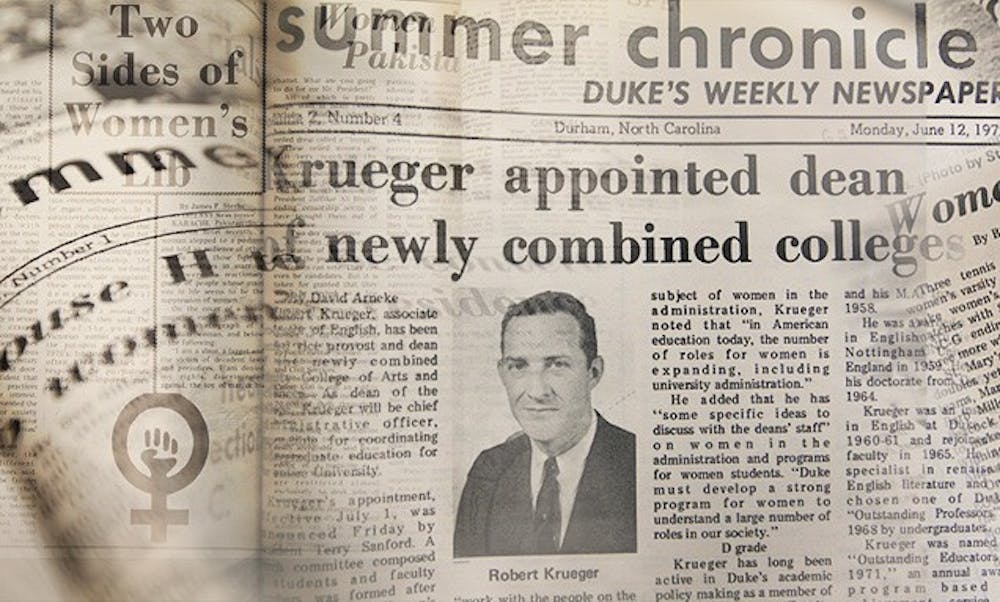This weekend’s biennial Women’s Weekend marks the 40th anniversary of the historic merger of the Woman’s College and Trinity College, as well as the establishment of women’s varsity athletics.
The weekend festivities, titled “Winning Women: Advocates, Educators and Athletes,” kicks off with a welcome reception hosted by Cynthia Brodhead Thursday, wrapping up with a Chapel service Sunday. Events include networking sessions, a women’s gala and a luncheon on the lasting legacy of Title IX for women’s education and athletics, featuring Nancy Hogshead-Makar, Trinity ’86 and three-time Olympic gold medalist, and Eleanor Smeal, Woman’s College ’61.
Former President Nannerl Keohane—Duke’s only female president—and current President Richard Brodhead will also host a panel discussion Saturday.
“[The reunion] is a celebration of Duke’s great women athletes and the accomplishments of the female scholars during the transitional period of the merger and years since then,” said Donna Lisker, director of the Women’s Center and associate vice provost of undergraduate education. “It will be a wonderful opportunity for current students and athletes to learn more about the pioneers who changed women’s history here at Duke.”
The 1972 merger was a response to the national trend of gender integration in higher education, said Trustee Ann Pelham, Trinity ’74 and former Chronicle editor. The merger led to a University where women could take classes alongside men, while still able to live in the all-female East Campus. Pelham, who plans to attend Women’s Weekend, said that she viewed the upcoming event as a much needed commemoration of women athletes. Alumnae will be able to gather in honor of the accomplishments of women students and athletes at Duke—who, by the time of the merger, had already been fully integrated in the academic arena.
Program participants will be able to meet with former women athletes Friday, followed by the women’s basketball game against Miami. Other events include the women’s lacrosse game and tennis match Saturday and special workout sessions designed specially for women.
‘A close-knit community’
The Woman’s College—initiated in 1930 with a $100,000 donation given by Washington B. Duke to Trinity College—provided women with an avenue to higher education at a time when many educational opportunities were closed off to women.
The merger provided benefits to both women and men, giving female students equal footing as men and placing them in direct competition with one another, Lisker said.
The unification of the institutions, however, did not occur without some friction.
“We lost a set of deans who were wonderful advocates for women at Duke,” Pelham said. “Women benefited from that support structure, although many probably did not appreciate it at the time.”
A graduate of the second co-educational class of Trinity College, Pamela Stone Schearer, Trinity ’73, noted that combining the schools proved to be more complex than her peers at the Woman’s College had anticipated. Stone added that although her class had been transitional, women at Duke had already moved beyond the organizational confines of the Woman’s College.
The transition was mediated by the implementation of measures that allowed women to maintain a single-sex community in some respect on East Campus. Stone added that she and her peers enjoyed being a part of the coed curriculum offered on West Campus while still maintaining the support system of a single-sex community.
“I treasured the experience of having a separate residential community from Trinity, especially the comfort that comes with having a close-knit community of women,” Stone said.
She added that many women had hoped to remain on East even after the merger.
Eventually, Duke took steps to make East Campus coed as well. Pelham noted that this new residential system, in some ways, lost the sense of community that had been created over many decades at the Woman’s College, where nearly every dorm included older female students who served as role models for the younger women.
Take the lead
In addition to residential changes, women had to reconfigure leadership roles within a coed campus. Forty years later, women are still markedly absent in some leadership roles on campus, Lisker noted.
She added that although there has been much progress since the two colleges merged, women still face many hurdles in higher education. Lisker said executive leadership positions—including those in Duke Student Government—are still disproportionately filled by male students.
“When I first came to Duke, I had been pleasantly surprised that the current president of DSG was a female, but little did I know that it was a rare accomplishment,” Lisker said.
She added that many women are intimidated by the election process—integral to acquiring many high power positions on campus—and some women equated certain leadership positions with being too assertive.
When the two campuses merged, there was a need for women to assume greater leadership roles in the community—not only for gender equality but also to strengthen the position of students against the administration, said Mary Earle Chase, Woman’s College ’67 and former president of the Women’s Student Government. Chase played a large role in advocating for a unified student body by merging the student governments of the Woman’s College and Trinity College.
“Looking back, I think that my determination for the unification of the two student bodies was a product of the place and time,” Chase said.
She noted that even though women were subject to a number of regulations that did not apply to male students—such as mandating strict weeknight and weekend curfews and setting certain clothing requirements—the restrictions were seen as a struggle between the students and the administrators, as opposed to one between genders.
Looking forward, Lisker noted that achieving more opportunities for women is an ongoing goal.
“We understand that this is challenging [for women] in the kind of environment Duke may cultivate, but this is exactly what women at Duke must be doing in order to further their accomplishments, ” Lisker said.
Get The Chronicle straight to your inbox
Signup for our weekly newsletter. Cancel at any time.

